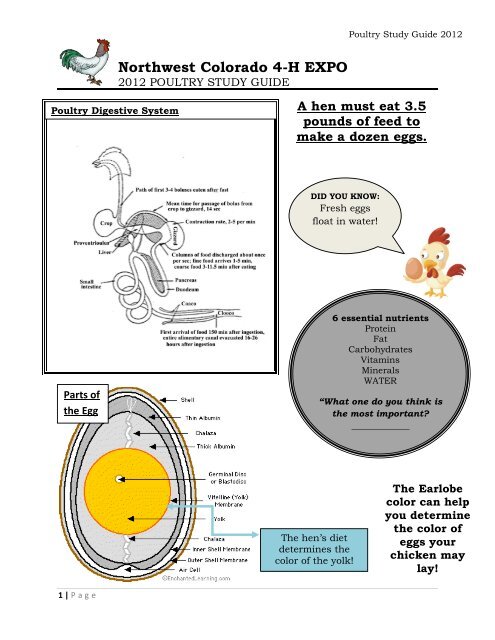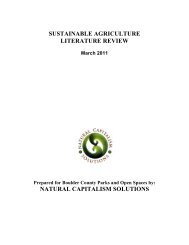Northwest Colorado 4-H EXPO - Colorado State University Extension
Northwest Colorado 4-H EXPO - Colorado State University Extension
Northwest Colorado 4-H EXPO - Colorado State University Extension
Create successful ePaper yourself
Turn your PDF publications into a flip-book with our unique Google optimized e-Paper software.
Poultry Digestive System<br />
Parts of<br />
the Egg<br />
1 | P a g e<br />
<strong>Northwest</strong> <strong>Colorado</strong> 4-H <strong>EXPO</strong><br />
2012 POULTRY STUDY GUIDE<br />
Poultry Study Guide 2012<br />
A hen must eat 3.5<br />
pounds of feed to<br />
make a dozen eggs.<br />
DID YOU KNOW:<br />
Fresh eggs<br />
float in water!<br />
The hen’s diet<br />
determines the<br />
color of the yolk!<br />
6 essential nutrients<br />
Protein<br />
Fat<br />
Carbohydrates<br />
Vitamins<br />
Minerals<br />
WATER<br />
“What one do you think is<br />
the most important?<br />
_____________<br />
The Earlobe<br />
color can help<br />
you determine<br />
the color of<br />
eggs your<br />
chicken may<br />
lay!
Thigh Wing<br />
Split Breast with Back Boneless Breast Drumstick<br />
2 | P a g e<br />
Poultry Study Guide 2012<br />
Parts of a<br />
Chicken<br />
It is important to be<br />
able to identify the<br />
parts of your 4-H<br />
animals. Study this<br />
picture and practice<br />
identifying the<br />
parts.<br />
DID YOU<br />
KNOW: Poultry<br />
is a great source<br />
of protein!
3 | P a g e<br />
Poultry Study Guide 2012<br />
Know the names and a few characteristic of different breeds of cattle:<br />
Angus: These animals are polled (no horns) with a black coat. They are know<br />
for their carcass quality, milking and mothering and their<br />
reproductive traits. They are the most popular breed of<br />
cattle in the United stated.<br />
Herford; Plymouth These Barred animals Rock: are red The with Plymouth white faces was and bred can in the<br />
be polled 19 or horned. They were brought the United<br />
<strong>State</strong>d in 1817. They became popular due to their<br />
hardiness, feed efficiency and disposition.<br />
Simmental:<br />
Charolais<br />
Gelbvieh<br />
Limousin<br />
th Knowing the names and a few characteristic of<br />
different breeds of poultry is important.<br />
Match the breeds of<br />
poultry with the<br />
pictures.<br />
century in New England. They are a dual purpose<br />
breed, meaning they are excellent layers and meat birds.<br />
They lay about 200 large eggs a year that is light to<br />
medium brown with a shade of pink.<br />
A.<br />
Silkie: This is a bantam breed known for their unique<br />
plumage that feels like silk. Their black meat is<br />
considered unpalatable in Europe but a delicacy in the<br />
Orient. They are docile and come in a variety of colors<br />
C.<br />
E.<br />
B.<br />
D.<br />
F.<br />
Definitions: Orpington: This heavy New England heavy breed is dual<br />
Bull: purpose Male chicken. animal They have a large frame with heavy<br />
Heifer: plumage Female making animal them that appear has not big. yet They calved produce 110-160<br />
Steer: light brown Castrated to tinted male white eggs a year<br />
Fattening: The process of deposition energy in the form of fat<br />
within Rhode the body Island tissue Red: This is a utility bird, raised for meat,<br />
Gestation: eggs and The showing. length of They time are an animal tough, is resilient pregnant and<br />
Cud:<br />
aggressive<br />
The<br />
making<br />
bolus of<br />
them<br />
eaten<br />
excellent<br />
feed which<br />
free<br />
is regurgitated<br />
rangers. They<br />
and<br />
are<br />
further chewed.<br />
excellent egg layers, laying 250-300 eggs per year. They<br />
Expenses: items that you have purchased for your project<br />
Profit:<br />
were developed<br />
when your<br />
in Massachusetts<br />
income is larger than<br />
and Rhode<br />
your expenses<br />
Island.<br />
Loss: when your expenses are larger than your income<br />
Breakeven: Langshan: The This price heavy per pound breed you originated need to cover in China. your total It can<br />
expenses be colored black, white or blue. The hens lay 140-150<br />
Intravenous-applying eggs a year and medication are good winter for the layers. benefit Their of the animal eggs are<br />
directly brown into with the blood a plum-colored flow bloom.<br />
Subcutaneous: Applying medication for the benefit of the<br />
animal under the skin<br />
Intramusclar: Cornish applying Rock: This medication is the ultimate for the benefit meat of bird the animal having<br />
into<br />
genes<br />
the muscle<br />
that contribute to build a vast broiler industry. It’s<br />
muscle development and arrangement give excellent<br />
carcass shape. Their meat is fine with thick white<br />
breasts. This English breed comes in four color varieties:<br />
Dark, White, White Laced Red and Buff.
It takes a hen<br />
23-32 hours to<br />
produce an egg!<br />
Poultry Combs<br />
4 | P a g e<br />
Animal Health<br />
Poultry Study Guide 2012<br />
It is very important to be able to monitor the health of your<br />
animal and be able to properly treat the animal as need.<br />
Never give medication to your animal without a parent ,<br />
vet or your 4-H leader.<br />
To properly give medication to animals you must be able<br />
to understand the medication label. Be able to identify:<br />
o Name of the drug<br />
o Name of the distributor<br />
o Storage instructions<br />
o Withdrawl time<br />
o Quantity of contents<br />
o Active ingredients<br />
o Cautions and warnings
5 | P a g e<br />
Poultry Study Guide 2012<br />
Definitions:<br />
Roughage: High fiber low energy feeds (example: hay)<br />
Concentrates: High energy low fiber feeds (example: corn)<br />
Conformation: The shape and design of an animal<br />
Pullet: A young turkey or chicken<br />
Cock: Male animal<br />
Hen: Female animal<br />
Chick: A new baby Chicken<br />
Hatching: A new chicken breaking open its egg/ being born<br />
Incubation: The length of time it takes for a chick to grow to hatch from<br />
an egg.<br />
Molt: Act of shedding or changing feathers<br />
Palatability: the degree to which a feed is liked or accepted by an animal<br />
Fattening: the process of depositing energy in the form of fat within the body<br />
tissue<br />
Dressing Percent: the amount of lean meat on a carcass. The more meat the<br />
higher the cutability<br />
Breakeven price: the price per pound you need to cover your total expenses<br />
Check: an egg with a broken or cracked shell with its contents not leaking.<br />
Immunity: the ability to resist infection.<br />
Comb: The fleshy body part of the poultry birds head<br />
Nutrients: The nourishing chemical substances such as proteins or minerals.<br />
Gizzard; The digestive part of poultry necessary for a bird to digest its food.
















